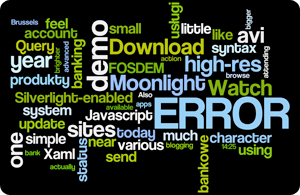Strategies for tagging content
15 Jan 2009 » permalink

Damn. I was trying to find this website I knew I bookmarked in my delicious bookmarks months ago. I even remembered why I got it bookmarked in the first place — it had unique design & colors, something inspiring for future. So I tried searching for design, colors, pretty, cool… lots of results, no luck with the site I was looking for. Made me think.
Now, I'm not actually browsing my delicious library that often. I'm mostly dumping stuff there and forgetting about it. So I started thinking — if I'm using it that scarcely and I can’t find what I'm looking for anyways, what’s the point of doing it in the first place?
Or maybe I'm just tagging the information wrongly? Let’s have a bird’s eye view at various strategies for tagging stuff.
Tagging for contents
Perhaps the most obvious way to tag is to describe the contents of the tagged object. In example, I'm applying tags julia to photos where my girlfriend is present. Similarly I'm tagging photos that contain me with mdk tag. The use case here is obvious: having this tags in place I can easily create a view (search) containing photos with both julia and mdk — the set of photos where we’re together in one picture.
It’s quite easy to overdo it. I've got some photos with tags such as winter, summer… what I was thinking? Photos in general have information about the time when they were taken — adding those tags is just duplication. Another example of over-commitment is ultra-fine-grained tagging. Some people on Flickr do it all the time describing with tags everything present on the photo.
If the picture is about a dog, the dog tag most likely makes sense. And if the picture is about a city street and the dog is just happening to be in the frame…
Tagging for content is not a universal solution to every data description problem. Sometimes it doesn’t work too good. Consider an example of a todo managing application where you can tag individual items that you need to get done. You might have an item there saying: “pay the phone bill”. Tagging it with bill, phone or even money is not that useful. It’s very unlikely you’ll use any of those keywords to look up this item in future.
Tagging for context
Instead, you should tag for context. If you’re using internet banking, your context in the above case is: banking. Next time you will be doing the internet banking chores you can list all the items with the banking tag and handle them in one go. That might include an item called “change the mailing address for the credit card statement” which also belongs to banking but is not directly about bills and money. Except for the context.
There is a creational difference between tagging for content and tagging for context. In the first case (tagging for content) we’re applying the tag to name (describe) something already existing in the tagged object. Ie. a person, following the photo example I've given earlier. When tagging for context, we’re adding new information to the target.
Another example: an “order new window blinds” todo item. When tagged with phone it gets a new meaning: the blinds need to be ordered via phone. Holding the phone in our hand is the context to get this thing done.
Tagging for feeling
Tagging data with information about the contents (tagging for content) creates fairly objective (universal) meanings. A cat tag on a photo has a quite obvious (and familiar) meaning to everybody. Adding contextual information using tags (tagging for context) still remains fairly objective, however the tag describes the tagger in relation to the tagged object. Ie. a phone tag on a todo item describes my relation to the object. So, we could say: the tag becomes a carrier of a personalized information.
Now, moving to the most subjective way of tagging — tagging for feelings. In this case we “stamp” the content with our feeling towards that content. An obvious example: putting a cool tag on a photo. Or on a file.
In this variant it’s sometimes useful to invent new categories and custom words which have a personalized meaning. An example: I might use a tag whichcraft to tag all the stuff related to my past girlfriends. This obviously has a meaning only to me (and maybe to others when explained).
Data tagged with feelings becomes more concrete and full — but only for the original tag author. Therefore, it makes most sense in cases where personal use and personal organization are involved.
The original problem
Coming back to the original problem of tagging a bookmark (an interesting site) for future reference — this use case requires me to use a mix & match of all of the above three tagging methods.
Firstly, I want to apply content tags: I want to use ruby and webdev if the website is about ruby and web development. Secondly, I want to apply some contextual information: ie. toread tag if I want to read the website later. Thirdly and lastly: I want to tag it with awesome if the website has great design and colors.
Since the context and feeling tags are “private” tags (they have meaning in relation to me) it makes sense to prefix them with a special character.
In the end, I might end up with a list of tags like this:
- ruby
- webdev
- @toread
- @awesome
- @rainbow
This way I can search for @awesome meaning specifically things I marked as awesome, not random content which just happens to have the word. And that — in most cases — does the trick.